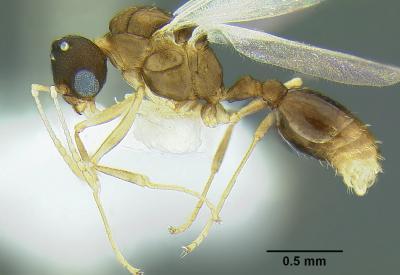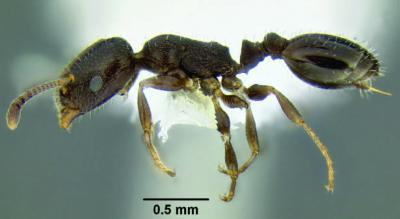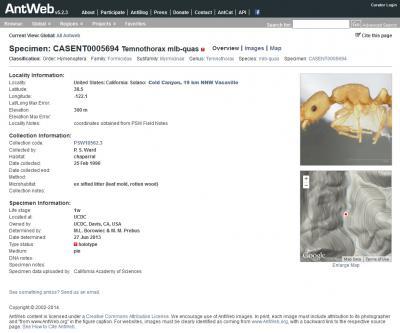A team of scientists from the Natural History Museum of Los Angeles and the University of California at Davis describe ten new species of Temnothorax ants, doubling the number of species of this genus in California. What makes this discovery even more special is that each described specimen is linked to the AntWeb database by a unique identifier. Publishing this way makes it easier to harvest the data by other on-line resources and repositories.
The era of electronic publishing in taxonomy has greatly facilitated the accessibility of specimen data. ZooKeys, where the new study is published, has been long spearheading the goal of wide and rapid dissemination of taxonomic information and a new publication in this journal is further taking the advantage of electronic media.

This image shows a male Temnothorax anaphalantus, one of the species described in the study.
(Photo Credit: Marek L. Borowiec)
As is customary in taxonomic descriptions, the authors are providing a list of material examined for each species. Each of the specimen records is marked by a unique specimen identifier, a number that links to a record page in the AntWeb database. This data is also supplied as a supplementary text file, making it easy for the readers to access, download, and analyze these records. The presence of this information in an external database allows harvesting by other on-line resources, such as Encyclopedia of Life, Global Biodiversity Information Facility (GBIF), Species-ID and ZooBank.

This image shows a worker Temnothorax arboreus one of the newly described species.
(Photo Credit: Marek L. Borowiec)
AntWeb is an online ant database that focuses on specimen level data and images linked to specimens. In addition, contributors can submit natural history information and field images that are linked directly to taxonomic names. Distribution maps and field guides are generated automatically. All data in AntWeb are downloadable by users.
"We include 20 species known from California in our study but at present, there are about 60 species (including those described below) of Temnothorax known from North America and more than 350 species worldwide so our study is of somewhat limited scope", explain the authors. "Nevertheless, we believe that by officially describing these forms and giving a new illustrated key, we are providing a useful resource for myrmecologists working in western North America."

This image shows the specimen data of one of the new species Temnothorax quasimodo, as it appears on AntWeb.
(Photo Credit: AntWeb)
Source: Pensoft Publishers